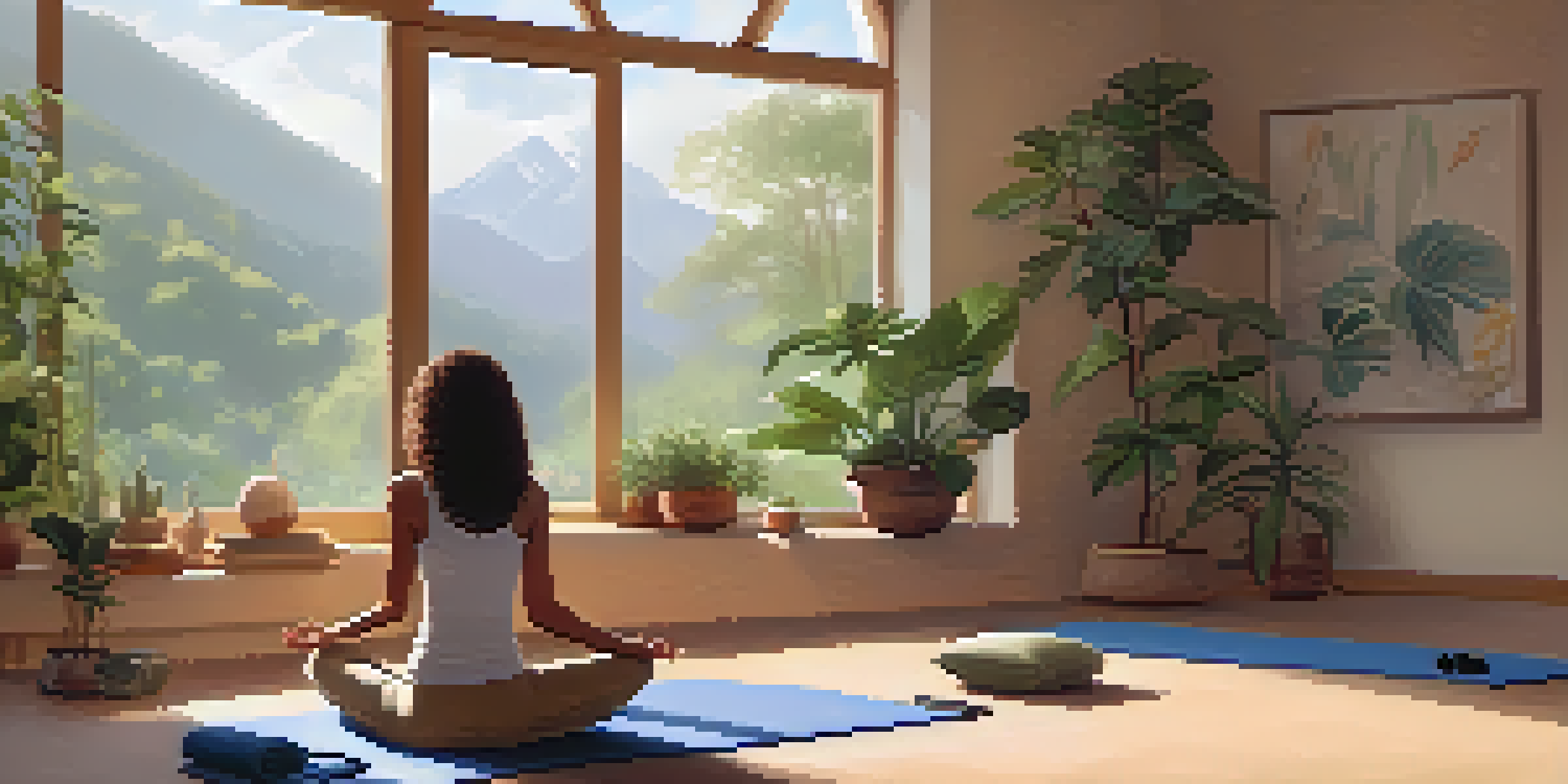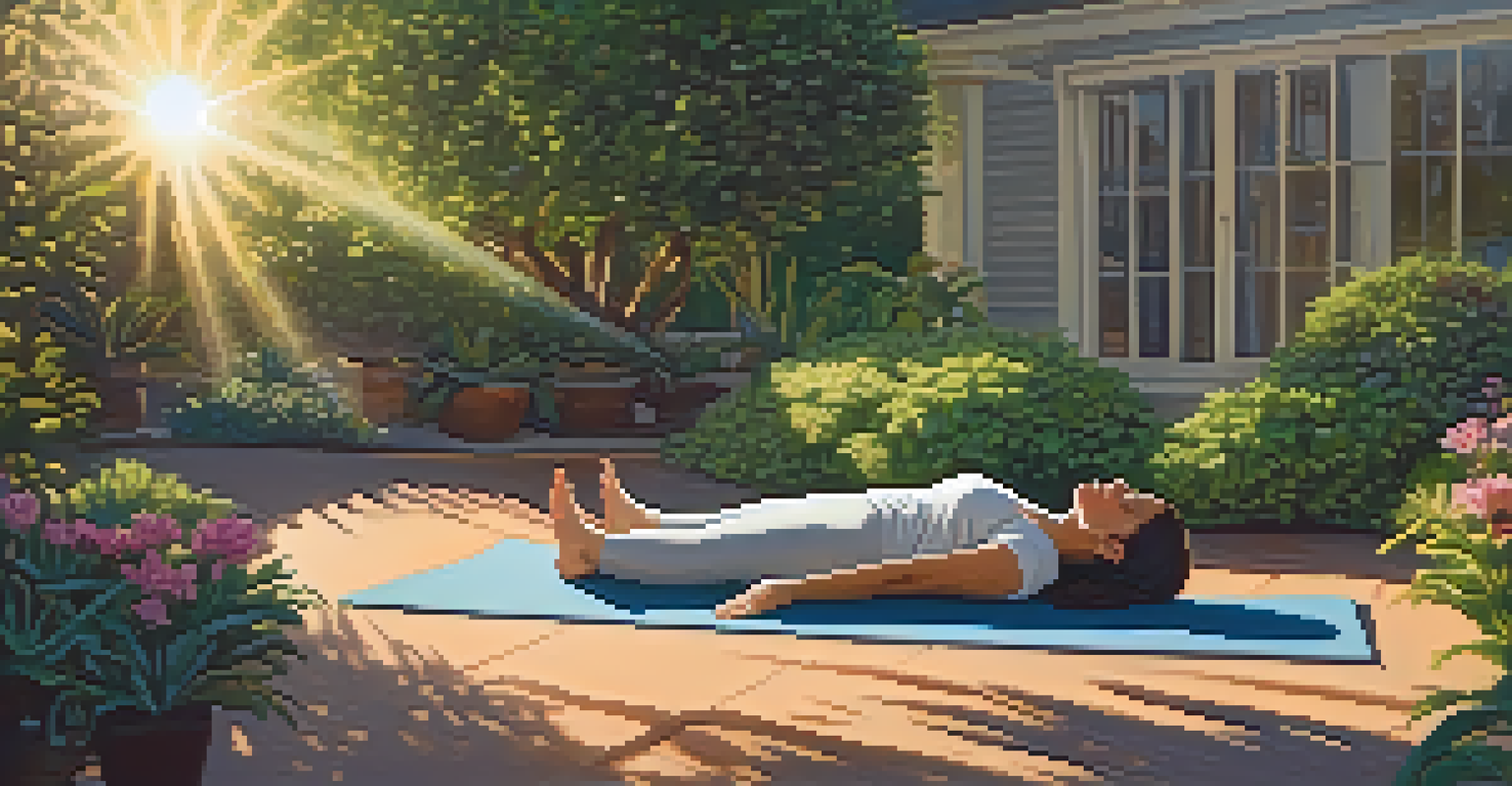Restorative Yoga Sequences for Different Emotional States

Understanding Restorative Yoga and Its Benefits
Restorative yoga is a gentle practice designed to relax the body and mind. It focuses on passive stretching and involves using props to support the body in various poses. This approach allows for longer holds, promoting deep relaxation and emotional release.
Yoga is the journey of the self, through the self, to the self.
By calming the nervous system, restorative yoga can help alleviate stress, anxiety, and emotional fatigue. The practice encourages mindfulness and introspection, creating space for healing and emotional balance. It’s like giving your mind a mini-vacation amidst the chaos of daily life.
Whether you’re feeling overwhelmed or simply seeking a moment of tranquility, restorative yoga can provide a safe haven. Understanding its benefits is the first step toward incorporating it into your emotional wellness toolkit.
Sequences for Stress Relief and Anxiety Reduction
When stress and anxiety take hold, restorative yoga can be a powerful antidote. Poses such as Child’s Pose and Supta Baddha Konasana invite the body to relax and release tension. These poses encourage deep breathing, which is essential for calming the mind.

In a typical sequence for stress relief, you might start with a few minutes of seated meditation, followed by gentle poses supported by props. The goal is to create a nurturing environment where you can let go of racing thoughts and physical discomfort.
Restorative Yoga Reduces Stress
By promoting deep relaxation and emotional release, restorative yoga effectively alleviates stress and anxiety.
As you flow through these sequences, you’ll likely notice a gradual easing of stress. It’s important to listen to your body and honor its needs, allowing yourself to sink deeper into relaxation with each breath.
Sequences for Emotional Healing and Processing Grief
Grief can be an overwhelming emotion, often leaving us feeling disconnected and heavy. Restorative yoga offers a compassionate way to process these feelings, with poses like Legs-Up-the-Wall and Supported Fish Pose promoting a sense of openness and release. These positions can help you physically embody the emotions you’re navigating.
The body benefits from movement, and the mind benefits from stillness.
In an emotional healing sequence, take time to integrate breath work and visualization. Imagine breathing in comfort and exhaling tension, allowing the poses to cradle you as you move through your emotions. This practice can help bring clarity and relief amidst the fog of grief.
Remember, it’s okay to feel vulnerable during these sessions. Embracing your emotions without judgment is a key aspect of healing, and restorative yoga creates a safe space to do just that.
Sequences for Boosting Mood and Energizing Spirit
On days when you’re feeling low, restorative yoga can help lift your spirits and energize your body. Poses like Supported Bridge and Savasana can be particularly invigorating when practiced with intention. They not only help release stagnant energy but also invite positive vibes into your space.
To create a mood-boosting sequence, incorporate uplifting music and essential oils to enhance the experience. Start with gentle stretches that open the heart and chest, followed by supported poses that encourage deep breathing and lightness.
Supports Emotional Healing
Restorative yoga provides a compassionate space to process grief and emotions, encouraging mindfulness and acceptance.
By the end of your practice, you might just find a renewed sense of joy and motivation. The beauty of restorative yoga is its ability to adapt to your emotional state, transforming your energy from heavy to light.
Sequences for Managing Anger and Frustration
Anger and frustration can be difficult emotions to navigate, but restorative yoga provides tools to manage them gracefully. Poses such as Extended Side Angle and Reclined Bound Angle can help release pent-up energy while also promoting a sense of calm. These poses encourage you to channel your feelings into physical movement.
In a sequence for anger management, focus on breath control to enhance your ability to respond to emotions rather than react. As you hold each pose, visualize releasing tension and frustration with each exhale, creating space for peace and understanding.
This practice not only helps in processing anger but also teaches valuable skills for emotional regulation. Over time, you’ll find yourself better equipped to handle life’s challenges with grace.
Sequences for Cultivating Self-Love and Compassion
Practicing self-love is essential for emotional well-being, and restorative yoga can be a beautiful way to nurture this relationship with yourself. Poses like Supported Child’s Pose and Heart-Opening poses promote self-acceptance and compassion. They remind you to honor your feelings and your body.
In a self-love sequence, incorporate affirmations or gentle mantras to reinforce your practice. As you flow through restorative poses, repeat phrases like 'I am enough' or 'I deserve love.' This helps create a positive mindset and fosters a deeper connection with yourself.
Personalize Your Yoga Practice
Creating a personalized restorative yoga sequence allows you to address your unique emotional needs and foster self-awareness.
Through consistent practice, you’ll find that self-love becomes more than just a concept; it becomes a lived experience. Restorative yoga encourages you to embrace who you are, flaws and all, nurturing your emotional landscape.
Creating Your Own Personalized Restorative Yoga Sequence
Designing a personalized restorative yoga sequence can be a rewarding experience, allowing you to address your unique emotional needs. Start by identifying how you feel and what you hope to achieve from your practice. This reflection will guide you in selecting poses that resonate with your emotional state.
Incorporate a variety of poses that cater to your needs, whether you’re seeking relaxation, energy, or emotional release. Don’t forget to include props that provide support and comfort, as they are essential for a restorative practice.

Once you’ve crafted your sequence, allow yourself the time to explore it fully. Be open to adjusting it as you go, remembering that your emotional state may shift, and your practice should reflect that fluidity.
Making Restorative Yoga a Regular Part of Your Routine
Integrating restorative yoga into your regular routine can yield long-term emotional benefits. Aim to set aside dedicated time each week to practice, whether it’s a full session or a few minutes of restorative poses. Consistency allows you to cultivate a deeper connection with your body and emotions.
As you make restorative yoga a habit, pay attention to the subtle changes in your emotional landscape. You may find that you’re better equipped to handle stress, navigate difficult emotions, and celebrate joyful moments.
Ultimately, restorative yoga is about creating space for yourself—both physically and emotionally. By prioritizing this practice, you’re investing in your well-being and nurturing a deeper understanding of your emotional self.